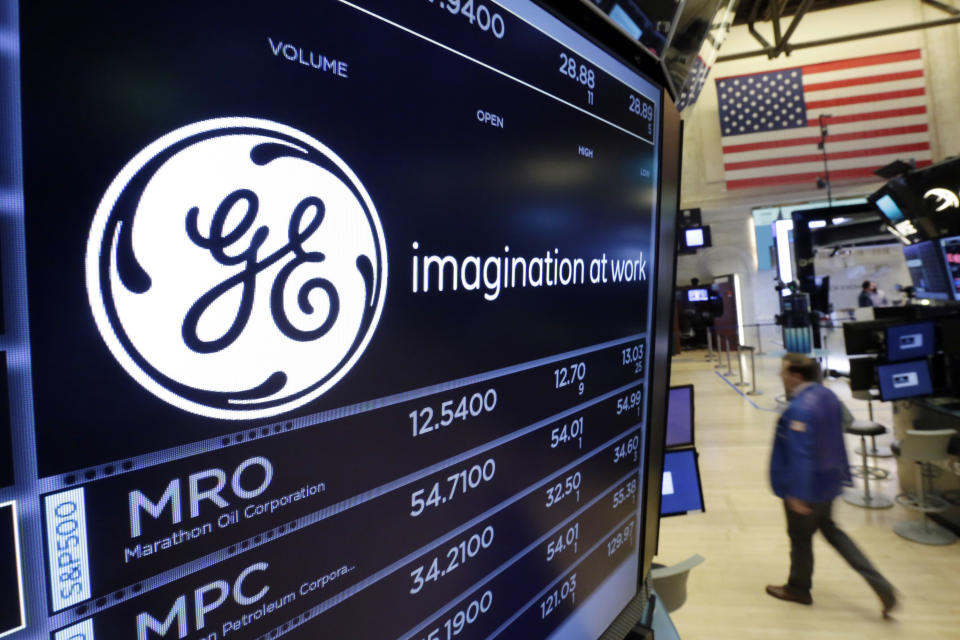‘The last of the 100-year breed’: Here's what's left of GE
General Electric (GE) beat earnings expectations when it reported second-quarter results on Friday, but its profit dropped 28% amid weakness in its power business.
General Electric, one of the greatest American conglomerates, has had a rocky few weeks. It was kicked off the Dow last month and has been selling off its businesses, part by part. Earlier this month, the company also said it would spin off GE Healthcare in an effort to shrink its debt, on top of plans to sell off its stake in oil services group Baker Hughes.
It’s also agreed to spin off its railroad business, and it’s even been trying to get rid of its iconic light-bulb division.
‘The last of the 100-year breed’
So what’s left of the former global empire? Its core businesses include aviation, power, and renewable energy; it’s also still in the 3-D printing, financial services, and digital businesses.
“GE brought electricity to Americans, brought appliances to kitchens.. it’s left its imprint, it’s accomplished much of what it sent out to accomplish,” said Aswath Damodaran, finance professor at New York University.
“Facebook one day, will be an old company, and definitely will not last a 100 years.”
“GE is going to be the last of the 100-year breed. The companies of this century have no chance of lasting a 100 years — the Facebooks and Googles. Technology is a very harsh taskmaster.”
An American icon
GE was born out of a merger between Thomas Edison’s Edison Electric Company and the Thomson-Houston Electric Company in 1892, which was arranged by financier J.P. Morgan. For the next century, it grew along with the economy. It became a founding member of the Dow in 1896.
In 2000, GE was generating almost $130 billion in revenue. At its height, the global giant was a lender, an appliance maker, a media giant (with NBCUniversal), and a healthcare business.
GE’s cash cow was GE Capital, its financial services unit. But the 2008 financial crisis turned that lucrative business into a liability, and the company hasn’t quite recovered since.
GE’s remaining core businesses
Aviation
GE is among the world’s biggest manufacturers of jet engines for commercial and military planes. The company makes GEnx for the Boeing 787 Dreamliner and Boeing 747-8. It also makes the GE90, one of the world’s most powerful engines, for the Boeing 777s, as well as CF6, which powers a variety of Airbus and Boeing flights.
Meanwhile, GE Capital Aviation Services, is, according to GE, the world’s leading commercial aircraft and engine lessor and lender.
Power
This struggling division is known for its natural gas power plants, and also includes steam, nuclear power, and grid services. GE Power says it generates one-third of the world’s electricity.
Renewable energy
GE Renewable Energy utilizes onshore and offshore wind and hydro technologies, along with other technology like concentrated solar power.

GE’s remaining parts
Additive
GE has invested heavily into additive machines, aka, 3-D printers. In 2016, it spent more than $1 billion for controlling stakes in two major makers of 3-D printers — Sweden’s Arcam AB and Germany’s Concept Laser. In his 2016 report for shareholders, former CEO Jeff Immelt said that the company planned to earn $1 billion in revenue from additive equipment and services by 2020.
Capital
GE’s crown jewel was hit by the 2008 financial crisis and hasn’t recovered since. The financial arm of GE provided commercial lending and leasing to support GE’s industrial business units. Analysts have assigned little to no value to the company, according to Barron’s.
Digital
Created in 2015, GE’s digital arm combines the company’s software center, its IT and commercial software teams, and technology from the cybersecurity firm Wurldtech.
In November, GE’s current CEO, John Flannery, said the company was slashing expenses at GE digital by 25% as part of creating a “much for focused strategy,” The New York Times reported.
‘GE’s gone — it’s over’
Still, Flannery is upbeat about GE’s future. In an interview with Mic, he said, “Take a fresh look at G.E… It’s gone through a period of incredible adversity. Plenty of people have written it off and said, ‘Hey this is not an interesting company.’ It’s an amazing company.”
But industry watchers might not be as enthused.
While some companies do manage to come back from the dead like Disney and IBM in the 1980s, “most of the time, the story is much like GE and Proctor & Gamble — storied brands where investors take over the company and sell it off in pieces,” said Steve Blank, an entrepreneur and adjunct professor at Stanford University.
“Flannery is doing one option — because he has no choice — to sell off the pieces. But GE’s gone. It’s over.”
This post was originally published on July 2 and updated after GE reported its second-quarter earnings.
Read more:
